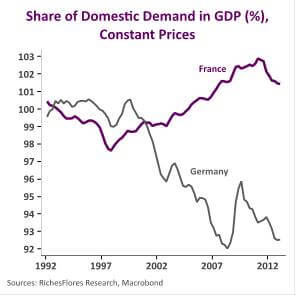Download the article
Although the French government has repeatedly described its 3-percent deficit target for 2013 as “inviolable,” this claim should be taken with a large grain of salt. The fact that investors are willing to pay to hold French sovereign debt suggests that the government has done a good job communicating—no small achievement just when one neighboring country after another is forced to borrow at exorbitant rates. But let’s not be gullible: there is no way that France can meet its target. Even if the official growth forecasts were accurate—0.3 percent in 2012 and 1.2 percent in 2013—this would be an ambitious goal. If the economy goes into negative territory, it will be downright unattainable. Coming after three quarters of stagnation, the steady slide in economic activity since early summer will push France into a full-blown recession. We estimate that GDP should basically be flat this year, before decreasing by at least 0.7 percent on average next year. This differs markedly from the government’s current forecasts, the basis for its budgetary assumptions for 2012 and 2013. With a shortfall totaling 2.3 points of GDP (0.4 points in 2012, 1.9 points in 2013), meeting the 3-percent target in 2013 would require cuts equal to 3.6 points of GDP over those two years, in contrast to the 2.6 points initially forecast!
In other words, it would require unprecedented savings, two thirds of them in the coming year. If actually carried out, they would make France the eurozone’s star pupil in the field of fiscal retrenchment, but it seems unlikely they will be. In fact, it seems more like the government is playing with dynamite.
 Like all crises, the present one provides a fertile breeding ground for dogmatic, cookie-cutter statements and clichés that don’t always square with reality. So perhaps the best way to avoid making disastrous decisions on the momentous issues of today is to take a good, hard look at our past. This view was what prompted us to publish the following series of charts, which sum up twenty years of comparative economic history in France and Germany.
Like all crises, the present one provides a fertile breeding ground for dogmatic, cookie-cutter statements and clichés that don’t always square with reality. So perhaps the best way to avoid making disastrous decisions on the momentous issues of today is to take a good, hard look at our past. This view was what prompted us to publish the following series of charts, which sum up twenty years of comparative economic history in France and Germany.